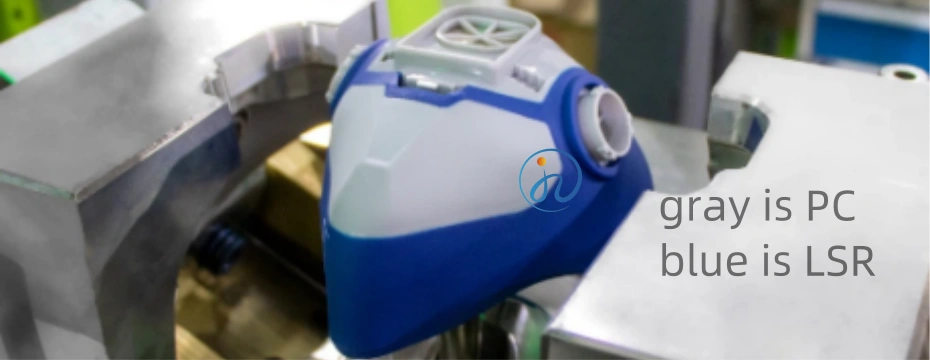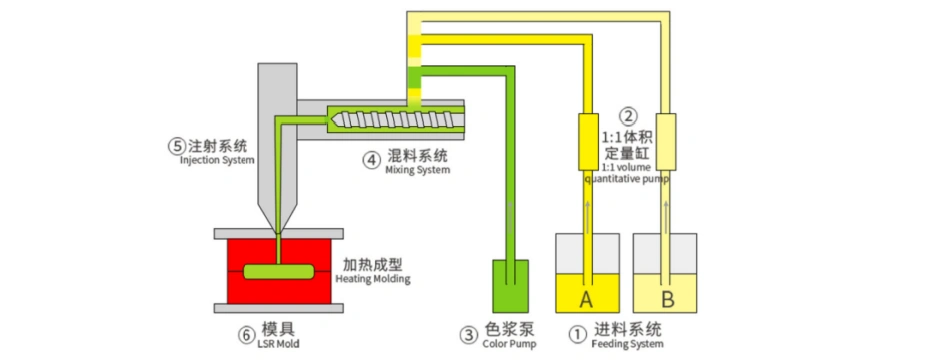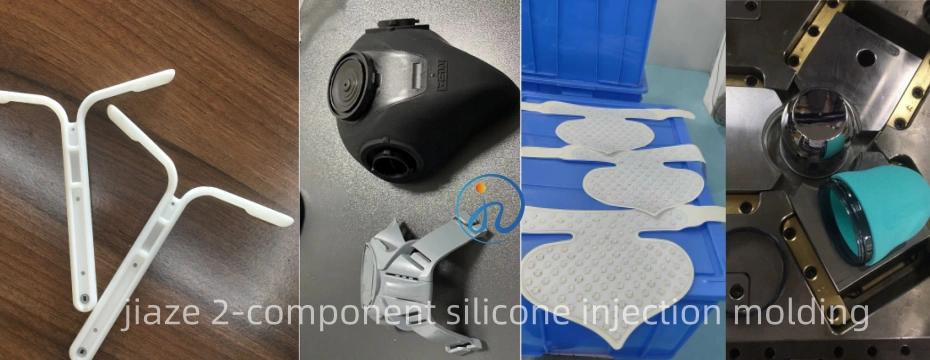2-component silicone injection molding combings the plastic material and the LSR material in a single manufacturing process. It is an advanced manufacturing process used to produce complex, high-performance parts by simultaneously molding two different materials—usually Liquid Silicone Rubber (LSR) and a thermoplastic. It This technique has revolutionized many industries, including medical, automotive, consumer electronics, and kitchenware, by enabling the integration of soft-touch silicone components with rigid thermoplastic structures.

1, What Is 2-Component Injection Molding?
2-component injection molding, also known as 2K molding or multi-shot molding, is a manufacturing process that involves injecting two different materials into a single mold during one continuous cycle to form a single integrated part.
In the context of silicone molding, this typically means combining a thermoplastic resin (e.g., polycarbonate, nylon, ) with liquid silicone rubber (LSR). The result is a component that leverages the structural rigidity of the thermoplastic and the elasticity, temperature resistance, and biocompatibility of silicone.
This process is distinct from overmolding, where materials are molded in two separate cycles. In contrast, 2K molding occurs in a single automated sequence, increasing precision and efficiency.
2. Materials Used
Liquid Silicone Rubber (LSR)
LSR is a two-part platinum-cured silicone that is pumped into the injection mold and vulcanized at high temperatures. Key properties include:
- High thermal stability (up to 200–250°C)
- Excellent flexibility and elasticity
- Biocompatibility and food safety (FDA, LFGB compliant)
- Resistance to chemicals, UV, and aging
- Electrical insulation properties
Thermoplastics
The requirement of thermoplastics used in 2 shot molding with LSR are Resistant to 200 degrees high temperature, no deformation within 5 minutes.
- Polycarbonate (PC) – Transparent, impact-resistant
- Polyamide (PA / Nylon) – High strength, wear-resistant
3. The 2-Component Molding Process

The 2-component injection molding process includes several steps and requires specialized equipment. Here’s how it typically works:
The first: Material Preparation
- Thermoplastic granules are dried and loaded into one injection unit.
- LSR components A and B are stored in separate drums, pumped into a static mixer, and delivered to the second injection unit.
Second : Mold Design
- A rotary mold, index plate, or core-back system is used to move the part from one cavity to another.
- The first cavity forms the thermoplastic substrate.
- The second cavity overmolds the LSR onto selected areas of the thermoplastic.
Next : Injection Cycle
- First Shot: Injecting and cooling thermoplastic in the first cavity.
- Transfer: The mold rotates or slides to align the partially formed part with the second cavity.
- Second Shot: Injecting LSR over or into the thermoplastic component.
- Curing: The LSR vulcanizes (crosslinks) inside the hot mold, forming a permanent bond.
- Ejection: The finished dual-material part is ejected and the cycle repeats.
The entire cycle can take between 30 and 200 seconds, depending on part size, complexity, and curing time.
4. Applications of 2-component silicone injection molding

Medical Devices
- Seals, valves, and overmolded handles for syringes or surgical tools
- Biocompatible parts with soft-touch surfaces
Automotive
- Sensor housings with integrated gaskets
- Vibration dampening components
Consumer Electronics
- Waterproof buttons and keypads on smartphones or remotes
- Soft silicone edges for impact protection
Kitchenware and Baby Products
- Sippy cups, bottle nipples, and food-grade seals
- Heat-resistant grips and suction pads
Industrial Components
- Electrical insulation parts, connectors, and grommets
- Wear-resistant seals and covers

Conclusion
2-component silicone injection molding is a powerful solution for producing high-quality, multifunctional components with integrated silicone and thermoplastic features. By offering design flexibility, strong adhesion, and superior performance, this technique supports innovation in diverse industries ranging from healthcare to electronics.
Although it involves higher complexity and initial costs, the long-term advantages—particularly for high-volume production—make it a valuable investment. As technology progresses and new materials become available, 2K LSR molding will play an even greater role in the development of next-generation products.